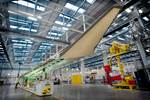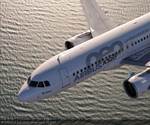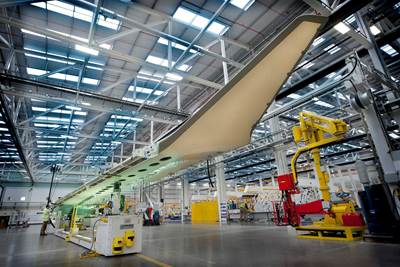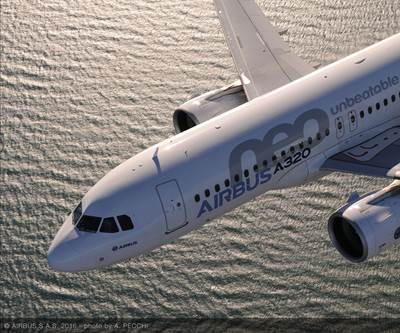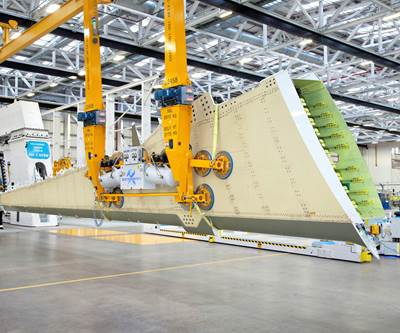Bombardier wins award for resin transfer infusion wing
The MacRobert Award 2019 recognizes reduction in parts, fasteners and weight using pioneering advanced composites technology.
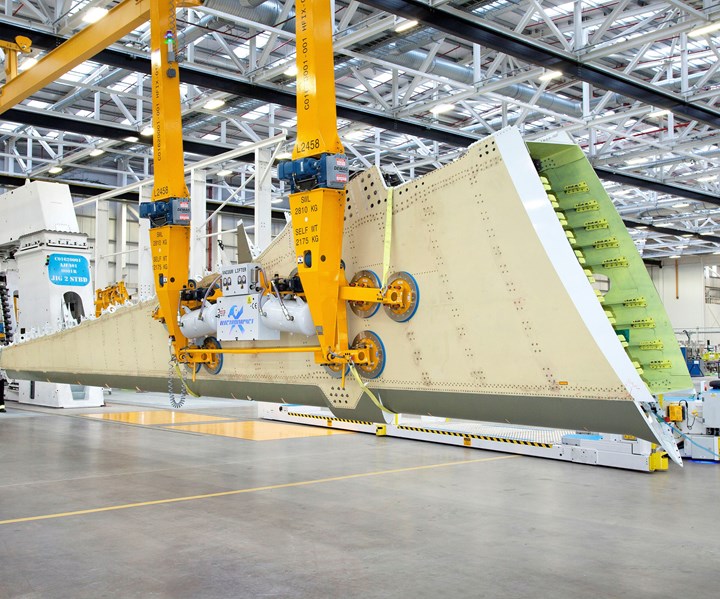
Bombardier’s Belfast, Northern Ireland facility is where the infused carbon fiber-reinforced wings on the Airbus A220 were developed. Source | Teijin
Every year, the Royal Academy of Engineering’s MacRobert Award, the U.K.’s most prestigious prize for engineering innovation, recognizes “teams that demonstrate outstanding innovation, societal benefit and commercial success.” In 2019, for its 50th anniversary, the award went to the Bombardier team in Belfast, Northern Ireland that developed and manufactures the world’s first resin-infused wing designed for the Airbus A220 commercial aircraft. Though the award was bestowed in July 2019, Solvay (Alpharetta, Ga., U.S.) is re-announcing the award and acknowledging its role as supplier of the resin used in Bombardier’s wing manufacturing process.
The innovative, resin-infused advanced composite aircraft wing, which currently flies on the Airbus A220, is the only certified commercial aircraft wing designed and produced with resin transfer infusion (RTI). The RTI process places dry fabric into molds, vacuum bagging and then injecting with liquid resin, which is then cured into shape using heat and pressure. The advantages of RTI are numerous, including the possibility of manufacturing large and complex one-piece structures, which reduces the need for many different parts and therefore fasteners; this in turn reduces waste during manufacture and improves aerodynamics. The use of dry fiber to create the structures also eliminates the need for the refrigerated storage of prepregs, saving energy and yielding materials that remain usable for a longer time, which also simplifies manufacturing.
By using fewer parts and fasteners, the RTI process results in a lighter wing. Compared to a conventional metal wing, Bombardier’s carbon composite wing is approximately 10% lighter helping to reduce fuel burn in flight, with an accompanying reduction of CO2 and NOx emissions.
The A220 is the only aircraft purpose-built for the 100-150 seat commercial transport market and entered service in 2016 as the Bombardier C Series. The £520 million investment in Bombardier’s aircraft wing program is the largest ever single inward investment in Northern Ireland. Around 200 suppliers across the U.K. are directly providing to the program, with many more throughout the supply chain tiers.
The nominated team members are: Mark Braniff, head of strategic technology, composites; David Patterson, engineering fellow, aerostructures; Trevor Poots, former chief manufacturing and tooling engineer; David Riordan, engineering fellow, engine nacelle design; and Sam Wilson, senior composites specialist.
“The Belfast-developed resin-infused composite wing epitomizes the best in U.K. mechanical engineering, bringing together excellence in design, materials engineering and manufacturing technology. It is a key enabling technology for the Airbus A220, creating a unique combination of range, fuel efficiency and environmental friendliness for an aircraft in this size range, and justifying its huge forward order book,” says MacRobert Award judge, Professor Ric Parker CBE FREng, on Bombardier.
“Resin infusion isn’t traditionally used in aerospace,” explains David Bacon, account manager at Solvay’s Composite Materials business unit. “It’s typically used to manufacture boats, and in the field of wind energy. But it’s obvious there is a lot to gain in spreading its use in commercial aircraft manufacturing.”
Bombardier developed their own RTI process for the wing at their large-scale manufacturing and assembly facility in Belfast, Northern Ireland. The wing was developed specifically for the Bombardier C Series aircraft programme, which subsequently became the Airbus A220 (following a partnership arrangement with Bombardier, Investissement Quebec and Airbus). It can so far only be found on this successful narrow body, medium range aircraft family, which entered service in 2016, though it seems only logical that other types of aircraft could be equipped with this new generation of lighter wings in the future.
Her Royal Highness The Princess Royal, as Royal Fellow of the Royal Academy of Engineering, presented the MacRobert Award to the team of engineers from Belfast-based company Bombardier in July 2019, the 50th anniversary year of the U.K.’s most prestigious engineering prize.
Bombardier was chosen from a shortlist of four finalists:
- Bombardier (Belfast) for developing an innovative, resin-infused advanced composite wing that minimizes the aircraft’s environmental impact by reducing both weight and fuel burn in flight, and waste during manufacture;
- Darktrace (Cambridge) for Antigena, an AI-powered ‘self-healing’ cybersecurity system that can both identify and neutralize cyberattacks;
- M Squared (Glasgow), whose SolsTiS Titanium:Sapphire laser produces the world's purest light and can be tuned across the spectrum - it is enabling new scientific discoveries and bringing about radical transformations in quantum computing, healthcare, navigation and climate change technology; and
- OrganOx (Oxford) for creating the metra, a world-first device that can keep a human donor liver functioning outside the body for up to 24 hours prior to transplant.
“The four finalists reflect the very best of U.K. innovation today, from mechanical, chemical, materials and optical, to medical and digital engineering. Each entry represents a significant advance in their respective fields and provides a glimpse of how engineering will shape the world over the next half century. They demonstrate UK engineering talent at the top of its game,” says Dr. Dame Sue Ion DBE FREng FRS, chair of the Royal Academy of Engineering MacRobert Award judging panel.
“Bombardier’s composite wing reflects how excellence in aeronautical engineering benefits both society and the environment. At a time of uncertainty for Belfast’s engineering community, we hope this award helps them achieve the world-wide recognition they deserve,” Ion adds.
“Bombardier Belfast is thrilled to win the Royal Academy of Engineering’s 2019 MacRobert Award. It’s a fantastic recognition of our highly-skilled workforce, who have created a unique, cutting-edge technology to produce composite wings in Belfast which fly on commercial aircraft around the world. I’m extremely proud of our employees’ engineering innovation, the significant support of our supply chain, and of Northern Ireland as a global leader in aerospace technology,” says Michael Ryan CBE FREng, COO of aerostructures at Bombardier Aviation. “We’ve been developing our advanced composite expertise in Belfast for half a century and it’s an immense honor to receive the gold medal in the MacRobert Award’s 50th year.”
“Bombardier’s innovative new wing is a worthy winner of the prestigious MacRobert Award for engineering innovation. We are committed to ensuring the future of aviation is cleaner and greener and the role industry will play is central to the U.K. achieving its sustainability goals,” says Baroness Vere, Aviation Minister.
Founded in 1969, the MacRobert Award is overseen by the Royal Academy of Engineering and is the U.K.’s longest running engineering prize. The Award honors the winning organization with a gold medal, and the team members with a cash prize of £50,000. It recognizes engineering teams that demonstrate outstanding innovation, tangible societal benefit and proven commercial success within the U.K. engineering sector.
Over the past 50 years, MacRobert Award winning innovations have changed the world, delivering enormous economic and societal benefit and contributing to the U.K.’s standing as the world’s eighth largest manufacturing economy.
The first award in 1969 was made jointly for two iconic innovations: to Rolls-Royce for the Pegasus engine used in the Harrier jump jet, and to Freeman, Fox and Partners for the Severn Bridge.
Other former winning innovations include:
- Allowing doctors to see inside the human body with the CT scanner invented at EMI (1972 MacRobert Award winner).
- Raising one of the world’s largest structures - the Millennium Dome, now the O2, engineered by Buro Happold (1999 MacRobert Award winner).
- Creating a computer the size of a credit card - Raspberry Pi (2017 MacRobert Award winner).
- Diagnosing cancer through a simple breath test - the ReCIVA breath biopsy developed by Owlstone Medical (2018 MacRobert Award winner).
Related Content
GKN Aerospace, Joby Aviation sign aerostructures agreement
GKN Aerospace will manufacture thermoplastic composite flight control surfaces for Joby’s all-electric, four-passenger, composites-intensive ride-sharing aircraft.
Read MoreCOMPINNOV TP2 project promotes use of thermoplastics in aerospace
Completed in 2023, COMPINNOV TP2 explored thermoplastic composites, enhancing the understanding between prepregs and production methods to foster the potential for French aerospace innovation.
Read MoreSmartValves offer improvements over traditional vacuum bag ports
Developed to resolve tilting and close-off issues, SmartValves eliminate cutting through vacuum bags while offering reduced process time and maintenance.
Read MoreNovel composite technology replaces welded joints in tubular structures
The Tree Composites TC-joint replaces traditional welding in jacket foundations for offshore wind turbine generator applications, advancing the world’s quest for fast, sustainable energy deployment.
Read MoreRead Next
What does the future hold for Bombardier Belfast?
Bombardier Belfast, fabricator of the infused composite wings for the Airbus A220 single-aisle aircraft, is for sale. The ownership under which this facility lands may say a lot about the future of infusion in large aerostructures.
Read MoreFACC secures three-digit million order from Bombardier
FACC will produce composites-intensive thrust reverser trans cowl components for the A320neo aircraft family, part of its first collaboration with Bombardier Belfast.
Read MoreBombardier to divest Belfast and Morocco aerostructures facilities
The divestiture is part of the company’s strategy to focus its aerospace operations into one Bombardier Aviation unit.
Read More

